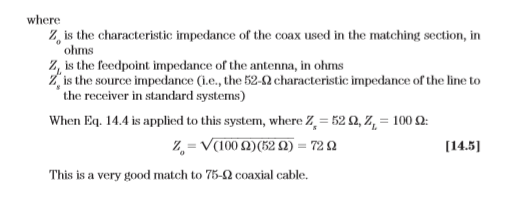The bisquare antenna - The bisquare antenna offers as much as 4-dB gain broadside to the plane of the antenna (i.e., in and out of the book page), in a figure-8 pattern, on the design frequency. It is horizontally polarized. When the frequency drops to one-half of the design frequency, the gain drops to about 2 dB, and the antenna works like the diamond loop covered previously.shown in Fig. 14-10, is similar to the other large loops, except that it is /2 on each side, making a total wire length of two wavelengths. This antenna is built like the diamond loop shown earlier (i.e., it is a large square loop fed at an apex that is set at the bottom of the assembly). In this case, the loop is fed either with an antenna tuning unit (to match a 1000-Ωimpedance) or a quarter-wavelength matching section made of 300-Ω or 450-Ω twin-lead transmission line. A 1:1 balun transformer connects the 75-Ω coaxial cable to the matching section. the bi-square is not quite a real loop since it is split at the top.

The bi-square antenna offers as much as 4-dB gain broadside to the plane of the antenna (i.e., in and out of the book page), in a figure-8 pattern, on the design frequency. It is horizontally polarized. When the frequency drops to one-half of the design frequency, the gain drops to about 2 dB, and the antenna works like the diamond loop covered previously.For bi-square Antenna many prefer use coaxial cable to the 300 ohm ribbon feedline to the bi-square normally uses.
If you think a single element quad loop (1 wavelength perimeter) is large, double its size to get an idea of the bi-square's dimensions. But despite what it looks like from a far, the bi-square is not quite a real loop since it is split at the top.
Still, if you have one tall tower (at least 3/4 wavelength high) the bi-square may be worth considering. It's basically a bidirectional gain antenna. If you've already got the wire the construction cost is low. And you may be able to use some ingenious remote switching with relays to change the antenna into a large loop for other bands.
 |
| 1/4 Lambda Bi-Square Antenna |
Another example project The Bi-Square antenna with four half-waves in phase, which makes it three half-waves and about 4 db better than dipole. The Bi-square to be described is for 15 meters , also success used for 20m and 40m band.
The advantages of this antenna are many. It's cheap , you need only one pole, 35 feet or over, to hang it on. It is bi-directional . you can hang two of them on one pole and cover 360 degrees. It's easy to tune. It has 4 dB Gain, which puts it in the well tuned two-element beam class. It is also good competition for the "pre-tuned" or untuned three-element beam. This Bi-square antenna can feed in to 150 watt Sideband Transmitter.
Reference : Practical Antenna handbook - Joseph J. Carr















